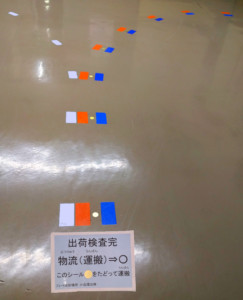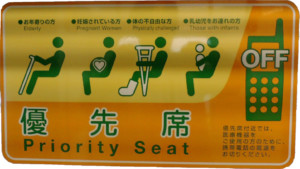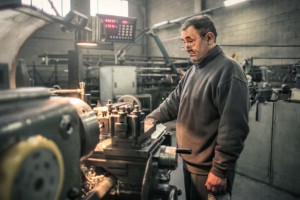 In my last post, I started to describe the factory tour at Omron Taiyo, where more than half of the employees are disabled. This post continues this interesting tour, also looks into the financial situation of their employees, and gives some suggestions for other companies.
In my last post, I started to describe the factory tour at Omron Taiyo, where more than half of the employees are disabled. This post continues this interesting tour, also looks into the financial situation of their employees, and gives some suggestions for other companies.
The Factory Tours – Part 2

Very interesting was also their material and information flows. Many intellectually disabled workers would not understand instructions like “Bring this box to the warehouse,” since they cannot really connect the words and the locations in their minds. However, they are able to follow colored lines and dots. Hence, there are lots of different-colored markers on the floor, matching the markings on the material. The intellectually disabled workers simply “connect the dots” as shown on the image.

Another visualization were boxes for defective parts. These boxes were transparent, and it was easy to see how many defects have accumulated.
They also have a kaizen employee suggestion system and kanbans, and use supermarkets extensively. Their kaizen activities are always on the shop floor. Managers are subject to a 360-degree feedback, where they are given feedback from their employees, their bosses, and their colleagues. Most workstations also have andon signal boards. Automatic workstations are filled before a break so that the machines continue to work throughout the break period. Their production lines seem to be a bit faster than in other factories. The switch line made six hundred switches per hour, or one every six seconds. Hence, the work content at a work station is only six seconds, which is less than what is considered optimal in other factories (thirty seconds to two minutes). Not quite sure why – if the limited mobility requires more customization of a task and reduces flexibility, or if intellectually disabled workers would have difficulties with longer cycle times.
 Many companies in Japan value cleanliness, and Omron Taiyo was no exception. Their method of cleaning wheelchair wheels when entering the factory, however, was quite ingenious. They had a piece of sheet metal in the floor with holes that were attached to a vacuum. However, since there were many holes, it would have to be a quite strong vacuum. Therefore they put a little spring loaded brush-topped stopper in each hole. Only if there was pressure on the brush did the hole open, and the vacuum cleaned the underside of the wheels or shoes.
Many companies in Japan value cleanliness, and Omron Taiyo was no exception. Their method of cleaning wheelchair wheels when entering the factory, however, was quite ingenious. They had a piece of sheet metal in the floor with holes that were attached to a vacuum. However, since there were many holes, it would have to be a quite strong vacuum. Therefore they put a little spring loaded brush-topped stopper in each hole. Only if there was pressure on the brush did the hole open, and the vacuum cleaned the underside of the wheels or shoes.
Compared to other companies, these companies do have higher absentee rates. Around 10 percent of the workforce is on sick leave on an average day. Note that sick leave is not paid in Japan. In any case, due to the higher fluctuation in the workforce, they do indeed need a bit more inventory to buffer these fluctuations, as they cannot let the customer wait.
Financials

The wages are not generous, but they are enough to live on. A new employee receives 140.000¥ per month (about $1,300 US), an experienced one gets around 180.000¥ (about $1,650 US), and the manager I spoke to received around 200.000¥ (about $1,800 US). On top of this, they receive a bonus (which is often one to two months’ salary per year) and also receive an additional pension for the disabled from the government. Overall they can afford their own place and a car. The company also has large dormitories for their employees next to the factories. This is common in Japan, and I have lived in such dormitories when I was working for Toyota. Many other companies that employ disabled people pay much less. For example, the Swan bakery in Tokyo that employs many disabled people pays around 100.000¥ per month (about $900 US ), although bakery wages are generally lower.
More important than money, however, is the impact on their self-respect. As I said earlier, Japan is a very communal society, and everybody is expected to contribute for the good of the society. Being unable to work is quite a stigma, and having work again and receiving a salary can be quite a boost for the self-esteem. One employee was so happy that when he got his first tax statement about how much taxes he owed the government, he framed it and put it on his desk as a proof that now he is contributing to society. I wish I could be as happy paying taxes …
Changing the World …
 Omron Taiyo does its bit to make the world a better place, to give a chance (not a charity) to disabled people, and to foster acceptance of disabled people in the society. As for myself, I never had much opportunity to interact with disabled people, and the whole topic is something new for me. Hence I approached these two tours a bit anxious. What is the right way to behave, what do I do so I don’t offend my counterparts, and so on. I knew the best way is to just behave normally, but, you know, if you try to behave normally, it is all a bit … off.
Omron Taiyo does its bit to make the world a better place, to give a chance (not a charity) to disabled people, and to foster acceptance of disabled people in the society. As for myself, I never had much opportunity to interact with disabled people, and the whole topic is something new for me. Hence I approached these two tours a bit anxious. What is the right way to behave, what do I do so I don’t offend my counterparts, and so on. I knew the best way is to just behave normally, but, you know, if you try to behave normally, it is all a bit … off.
With this mind-set of mine, we started the visit with a presentation and a video. After forty-five minutes, we were ready to go to the factory. I stood up to go to the factory, and then was surprised that my counterpart did not stand up, but rolled to the door in his wheelchair. In retrospect this should have been obvious, but at that moment I was surprised. I totally forgot that he was sitting in a wheelchair, and I just had a completely normal conversation like I would have with any other Japanese (with the limitation that my Japanese is quite bad).
Anyway, I like to think that these visits to Omron Taiyo in Beppu and Kyoto helped me to become a better person myself and made me feel more at ease around people with disabilities. In Beppu the guide even had a drink with me in the dormitory cafeteria afterward, and we chatted a bit about life, just like I would with everybody else (again, considering my limited Japanese skills). Omron Taiyo is changing the world, and it definitely helped me to change a bit for the better. Many thanks to my two tour guides in Kyoto and Beppu for their patience!
Improvements for Other Companies

I believe Omron is an impressive example on how to not only give work to disabled people, but to make it profitable. As their motto is “A chance, not a charity!” this hopefully gives inspiration to other companies. Also, while many Omron employees satisfy the legal definition of disabled, there are also many other similar but less drastic problems.
Old, Pregnant, Infirm …
 A common problem in industry is the aging workforce as a result of an aging society. Workers will get older, and their bodies may no longer be working as well as when they were young. Others may have a temporary injury that limits their ability to work, but not severe enough for complete absence. And others may be pregnant, which is neither a disability nor a disease, mind you, but which may limit the work that can be done by these women.
A common problem in industry is the aging workforce as a result of an aging society. Workers will get older, and their bodies may no longer be working as well as when they were young. Others may have a temporary injury that limits their ability to work, but not severe enough for complete absence. And others may be pregnant, which is neither a disability nor a disease, mind you, but which may limit the work that can be done by these women.
Using jigs, visualization, and ergonomic workplaces can also help these employees. It is usually a combination of finding a suitable workplace and changing the workplace so that it is suitable for the employee. For example, I know one plant manager that keeps one low automated manual assembly line of smaller products to give work to pregnant employees. Lifting aids can be used to help employees with back pain. Larger print on instructions and information is also more gentle on elderly eyes. On a motorbike assembly line, I have seen a particularly short employee whose station had a wooden plattform 15cm high, 1m wide, and 4 m long for him to work on the assembly. So there are many things you can do for your people depending on your circumstances.
Healthy Employees
 Above were a lot of ideas to allow the disabled and otherwise infirm to work productively. But these ideas would also work for otherwise healthy and able employees. Ergonomics keeps them healthier, and visual management reduces their errors, as does poka yoke (mistake proofing). Hence, a lot of these ideas benefit the entire workforce.
Above were a lot of ideas to allow the disabled and otherwise infirm to work productively. But these ideas would also work for otherwise healthy and able employees. Ergonomics keeps them healthier, and visual management reduces their errors, as does poka yoke (mistake proofing). Hence, a lot of these ideas benefit the entire workforce.
This completes my two-post series on my factory tour of Omron Taiyo in Kyoto and Beppu. It was very insightful for me, and I wanted to share these insights with you. Now, go out, enable everybody to use their full potential, and organize your industry!
P.S.: The company offers tours through their website www.omron-taiyo.com. Japanese skills would be helpful, although the site is in English. Many thanks also to Omron and the two tour guides for the tour.
P.S.: Many thanks to Tim Wolput from Lean Japan Study Tours for pointing out these companies to me!


That’s a very interesting experience you did with this factory tour. Did you visit Kumamoto plant or Kyoto Plant?
HI Frederic, i visited both plants 🙂
Very enlightening post! I do have some concerns about the six second switches line. Obviously there are some manual processes there. Are there any visible steps taken to protect workers from repetitive stress injuries? If someone has to do the same motion 600 times an hour, day in and day out, it’s pretty much guaranteed to result in either carpal tunnel or Dupuytren’s (aka “hook finger”) in a year or less. Both of those require surgery to fix, too…
Hi Andre, unfortunately I don’t have data on that. The tour did not allow for longer observations, but I also thought that that is a fast line.
Hello Roser,
I appreciate your hard work. You are a great motivational speaker for me as a wheelchair. I salute the Japanese for taking this step.